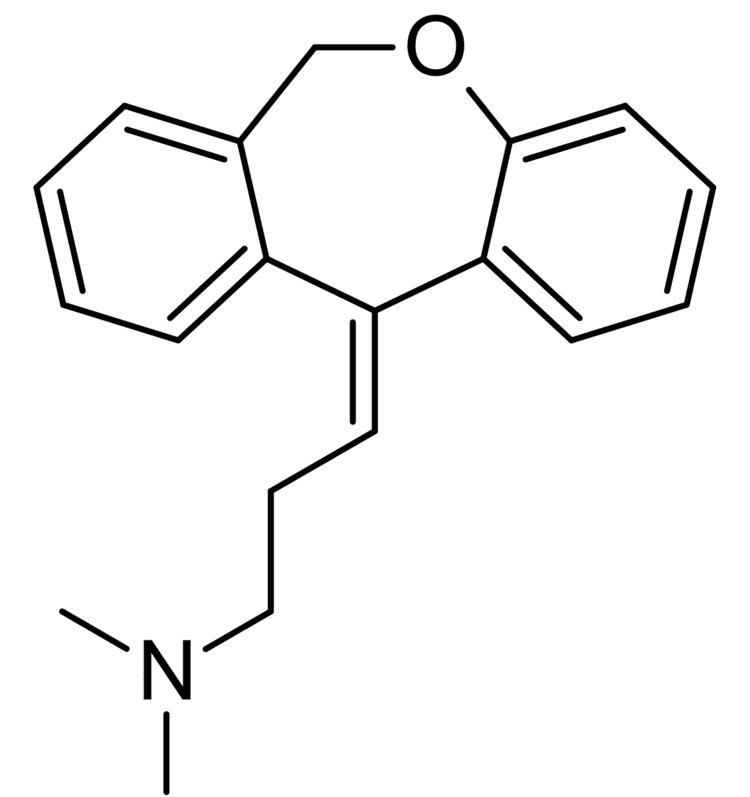Trade names Sinequan, others MedlinePlus a682390 Molar mass 279.376 g/mol Protein binding 76% | AHFS/Drugs.com Monograph License data US FDA: Doxepin CAS ID 1668-19-5 | |
 | ||
Pregnancycategory AU: CUS: B (No risk in non-human studies) Routes ofadministration Oral, topical, intravenous, intramuscular | ||
What is doxepin hcl
Doxepin is a tricyclic antidepressant marketed worldwide. It is marketed under many brand names worldwide.
Contents
- What is doxepin hcl
- Medical uses
- Pregnancy and lactation
- Contraindications
- Adverse effects
- Overdose
- Interactions
- Pharmacology
- Society and culture
- References
Medical uses
Doxepin is used to treat depression, anxiety disorders, itchiness, trouble sleeping, and as a second-line treatment of chronic idiopathic urticaria (hives). Its oral formulations are FDA-approved for the treatment of depression, anxiety, and insomnia and its topical formulations are FDA-approved the short-term management (up to 8 days) of atopic dermatitis and lichen simplex chronicus. Whereas in Australia and the UK, the only licensed indication(s) is/are in the treatment of major depression and pruritus in eczema, respectively.
Pregnancy and lactation
Its use in pregnant and lactating women is advised against, although the available preclinical (based on animal studies) evidence suggests it is unlikely to cause any deleterious effects on fetal development. The lack of evidence from human studies, however, means it is currently impossible to rule out any risk to the fetus and it is known to cross the placenta. Doxepin is secreted in breast milk and neonatal cases of respiratory depression in association with maternal doxepin use have been reported.
Contraindications
Known contraindications include:
Adverse effects
Overdose
Like other tricyclics (TCAs), doxepin is highly toxic in cases of overdose. Mild symptoms include drowsiness, stupor, blurred vision, and excessive dryness of mouth. More serious adverse effects include respiratory depression, hypotension, coma, convulsions, cardiac arrhythmia, and tachycardia. Urinary retention, decreased gastrointestinal motility (paralytic ileus), hyperthermia (or hypothermia), hypertension, dilated pupils, and hyperactive reflexes are other possible symptoms of doxepin overdose. Management of overdose is mostly supportive and symptomatic, and can include the administration of a gastric lavage so as to reduce absorption of the doxepin. Supportive measures to prevent respiratory aspiration is also advisable. Antiarrhythmic agents may be an appropriate measure to treat cardiac arrhythmias resulting from doxepin overdose. Slow intravenous administration of physostigmine may reverse some of the toxic effects of overdose such as anticholinergic effects. Haemodialysis is not recommended due to the high degree of protein binding with doxepin. ECG monitoring is recommended for several days after doxepin overdose due to the potential for cardiac conduction abnormalities.
Interactions
It should not be used within 14 days of using a monoamine oxidase inhibitor such as phenelzine due to the potential for serotonin syndrome to develop. Its use in those on CYP2D6 inhibitors such as fluoxetine or quinidine is recommended against due to the potential for its accumulation in the absence of full CYP2D6 catalytic activity. Hepatic enzyme inducers such as carbamazepine, phenytoin, and barbiturates are advised against in patients receiving TCAs like doxepin due to the potential for problematically rapid metabolism of doxepin to occur in these individuals. Sympathomimietic agents may have their effects potentiated by TCAs like doxepin. Doxepin also may potentiate the adverse effects of anticholinergic agents such as benztropine, atropine and hyoscine (scopolamine). Tolazamide, when used in conjunction with doxepin has been associated with a case of severe hypoglycaemia in a type II diabetic individual. Cimetidine may influence the absorption of doxepin. Alcohol may potentiate some of the CNS depressant effects of doxepin. Antihypertensive agents may have their effects mitigated by doxepin. Cotreatment with CNS depressants such as the benzodiazepines can cause additive CNS depression. Cotreatment with thyroid hormones may also increase the potential for adverse reactions.
Pharmacology
Doxepin is a reuptake inhibitor of serotonin and norepinephrine and acts as an antagonist of various serotonin, adrenergic, muscarinic, dopamine, and histamine receptors:
Society and culture
Doxepin is marketed under many brand names worldwide:
